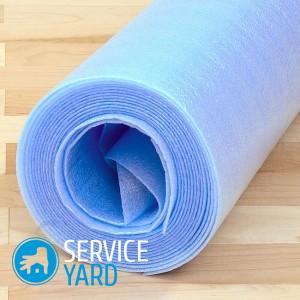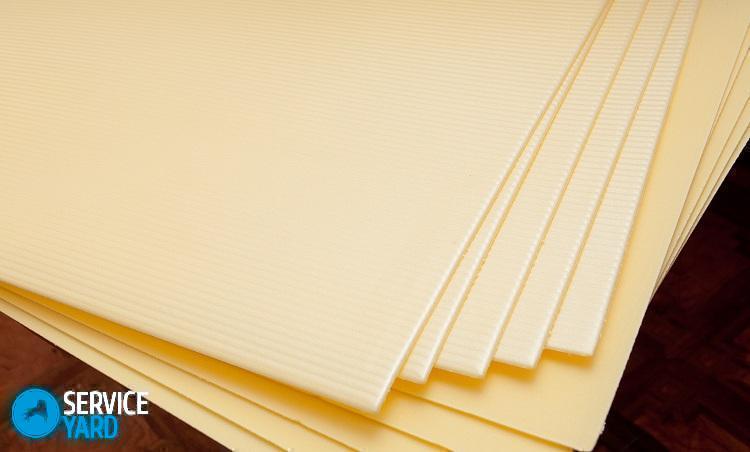Laminate underlay - which is better?

Today, laminate flooring is one of the most popular and inexpensive floor coverings. It is durable, durable, happy with a wide selection - from elite to budget models of any color. Often people spend a lot of time choosing a laminate, and they often forget about the substrate. In this article we will talk about what kind of substrate is needed for a laminate, which is better, because the durability of the floor covering will depend on its quality.
to contents ↑What is the substrate for?
The substrate for the laminate is needed using floating floor technology. This is due to some nuances, of which the following can be distinguished.
Soundproofing
If you do not use a substrate under the laminate, then each step will be given with a booming knock. The presence of an even and soft layer will mask small noises.
Important! Sometimes on the 32 and 33 classes of the laminate you can meet the built-in substrate: on the back side there is already an insulating layer. Such material is more convenient to stack than normal. However, due to a more complex production technology, its cost increases significantly.
Surface alignment
This is a very important function when laying the laminate, since the durability of the locks depends on how smooth the base is.
Important! According to technology, floor differences are allowed no more than 2 mm per 1 meter. But it is worth remembering that too large a thickness of the substrate will more likely prevent hiding irregularities, since it will not bend at the joints when walking.
So that after six months of use, the seams do not spread, the floor surface must be carefully prepared before laying the laminate.
Moisture insulation
The laminate is made of pressed paper, which is why even moisture-resistant models should not be exposed to excessive moisture, otherwise the panels will swell. Laying the substrate under the laminate ensures additional protection against moisture from the floor. For the same reason, before laying the laminate, it is advisable to wait a month after installing the concrete screed.
Important! As a test of the readiness of the concrete screed, you can put polyethylene on the floor at night. In the morning, there should be no condensation on the polyethylene.
Thermal conductivity
A conventional laminate substrate installed under underfloor heating reduces its efficiency, since both the substrate material and the laminate itself have good thermal insulation properties.
to contents ↑Important! For underfloor heating, there are special substrates.
Substrate Selection
In any of the construction stores, you can easily find many types, but how to choose the substrate for the laminate correctly? Materials differ in thickness, material, sound insulation.
First of all, you need to find out the condition of the floor on which the laminate will lie:
- If the base is perfectly flat, the thinnest 2 mm substrate will suffice.
- If there are small irregularities, then it is worth choosing a thickness of the insulating layer of 3 mm.
Important! The thickness of the laminate with the substrate will be approximately 10-11 mm (if you take the average thickness of the floor with the laminate at 8 mm).
Choosing the laminate itself and the substrate under it, it is not necessary to give preference to the same manufacturing company. It practically does not matter, since the parameters are common.
to contents ↑Polyethylene foam
The most common insulation layer is polyethylene foam.The popularity of this material is primarily due to its low cost. In addition, it has good moisture resistance, thermal insulation and is not subject to the action of microorganisms and rodents. This material is quite simple to use and minimizes waste.
Important! Often, such a substrate is supplemented with a foil layer with aluminum to effectively reflect infrared heat.
But despite all the advantages, the cheapest material also has many disadvantages. First of all, it is a synthetic, non-environmentally friendly material that, over time, sags and does not hold its shape very well.
to contents ↑Important! It happens that after laying the laminate on such a substrate, static electricity is formed (especially in rooms that are too dry), and sometimes the owners can be shocked.
Cork backing
Cork underlay for laminate flooring is perfect as a base for a floating floor. Although it is a natural material, the cork is not susceptible to decay and mold, remarkably insulates heat. Throughout the entire time of use, this substrate will retain its characteristics and dimensions.
Important! This type is made in sheets or in the form of rolls.
Due to the too high cost, it is considered inappropriate to use the cork option for cheap coatings, but as a long-lasting base, it will work well.
to contents ↑Important! The disadvantage of such a substrate is water permeability, due to which condensation may appear under the coating.
Bitumen-cork substrate
This material is made on the basis of kraft paper with the addition of bitumen, and then coated on top with fine cork crumbs. Sprinkling is made from small pieces of cork of approximately 2-3 mm.
Thanks to bitumen, this substrate is free from the disadvantages of a conventional cork:
- Delays sounds well.
- Does not leak moisture.
- Breathes, so condensation does not occur.
to contents ↑Important! Like the previous version, a bitumen-cork substrate is suitable for expensive types of laminate, because of its high price.
Expanded polystyrene
Extruded polystyrene foam is often used as an insulating layer. It is suitable for heavily loaded rooms and perfectly levels the surface. This is one of the most effective heaters due to the content of air in its composition.
Due to its stiffness, it perfectly absorbs sounds and does not allow moisture to pass, while maintaining its shape. When using this material as a substrate for a laminate, a comfortable feeling when walking is guaranteed.
to contents ↑Important! In this form, the most popular products are from Arbiton, Izoshum.
Combined Options
There is also a combination of expanded polystyrene and polyethylene. The most famous substrate is Tuplex, which consists of two layers of polyethylene, between which there are balls of expanded polystyrene.
Important! This combined look has a thickness of 3 mm and is sold in rolls.
The upper layer prevents the penetration of moisture, and a thin lower layer passing it inward to the granules, displays through technological gaps to the outside.
to contents ↑Coniferous tiles
We continue to consider further different options for substrates for a laminate, in order to understand which is better. A recent novelty in the building materials market is a coniferous underlay for laminate flooring. It is not often found in stores because of the high cost.
The material is completely natural, therefore environmentally friendly, so there will be no greenhouse effect under the floor. But the elasticity of the needles is somewhat inferior to the cork coating.
to contents ↑Important! It is also worth considering that the minimum thickness of coniferous tiles is 4-5 mm, which contradicts the requirements of the bulk of laminate manufacturers. These tiles are laid diagonally.
Insulation layer laying
After you have decided which one to choose the substrate for the laminate, you need to correctly lay it:
- If the floor is fresh concrete screed, then before laying the laminate, lay a layer of thin polyethylene 0.2 microns.
Important! In old houses, this is not necessary.
- Thoroughly clean the floor of debris by vacuuming all the dirt. The base must be completely dry.
- Use a construction knife for cutting. Make an overlap on the walls - then the skirting board will close it.
- In no case do not lay several layers to eliminate bumps - one layer of 2-3 mm will be enough.
Important! If you need more, then level the floor with a screed, plywood or in another way.
- If the material has corrugation, then lay it down with this side - so there will be less bumps.
Important! Foil material should be laid with its reflecting side up.
- Perform laying butt-to-head, without overlapping sheets on top of each other.
to contents ↑Important! To prevent the substrate from moving during operation, it is advisable to glue it to the floor using double-sided tape.
Stock footage
When you purchase high-quality materials and adherence to the technology, a floor decorated with a laminate can last you more than 10 years. Of course, when deciding which substrate to choose for the laminate on the concrete floor, the final choice will depend on your material capabilities, but it’s better not to stint and buy natural material.
- How to choose a vacuum cleaner taking into account the characteristics of the house and coatings?
- What to look for when choosing a water delivery
- How to quickly create comfort at home - tips for housewives
- How to choose the perfect TV - useful tips
- What to look for when choosing blinds
- What should be running shoes?
- What useful things can you buy in a hardware store
- Iphone 11 pro max review
- Than iPhone is better than Android smartphones




